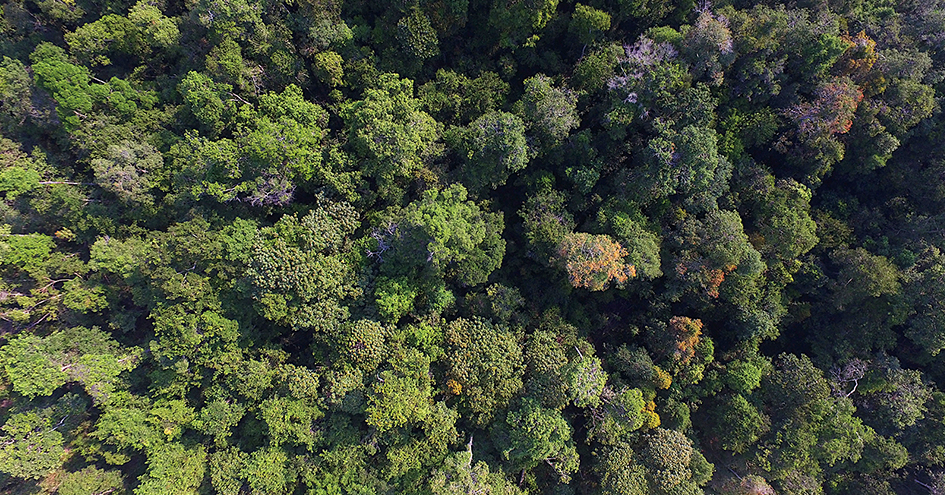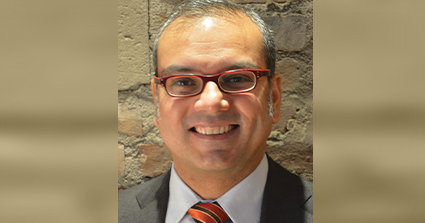Setting and Achieving Climate Change Goals
INPEX has set three goals to help realize a net zero carbon society in accordance with the objectives of the Paris Agreement.
The first goal is to achieve net zero emissions by 2050 pursuant to the Paris Agreement. The second is to achieve a reduction of at least 30% in net carbon intensity (compared to 2019) by 2030 in the process of fulfilling the first goal. Scope 1+2 emissions, which are emissions from INPEX’s business processes, come under these goals. The third goal is to cooperate with all relevant stakeholders across the value chain to reduce the Scope 3 emissions from combustion of the oil and gas we sell. In our 2022-2024 medium-term business plan, we have added the goal to reduce our emission intensity by 10% (4.1kg/boe) over three years in pursuit of our 2030 target.
Specific measures for achieving net zero goals include: (1) promotion of carbon capture utilization and storage (CCUS); (2) bolstering renewable energy initiatives; (3) promotion of CO2 absorption through forest conservation; (4) maintaining the intensity of methane emissions (methane emissions/natural gas production) at its current low level (about 0.1%); and (5) zero routine flaring. Details of these initiatives are set out in our Long-term Strategy and Medium-term Business Plan (INPEX VISION @2022) and INPEX’s Current Initiatives based on the Corporate Position on Climate Change.
Climate Change Goals
INPEX has set its own goals to help achieve a net zero carbon society in accordance with the objectives of the Paris Agreement.
|
CY2019 |
FY2020 |
FY2021 |
||||||
|---|---|---|---|---|---|---|---|---|---|
Scope 11 (thousand tons CO2e) |
8,557 |
7,328 |
7,302 |
||||||
Scope 21 (thousand tons CO2e) |
204 |
148 |
136 |
||||||
Net carbon intensity2 (kg CO2e/boe) |
41 |
35 |
33 |
||||||
Methane emissions intensity3 (%) |
0.10 |
0.07 |
0.04 |
||||||
|
|||||||||
INPEX's Net Carbon Intensity
Our net carbon intensity in 2021 was 33 kg-CO2e/boe, a reduction of 20% in comparison with 2019.
Making Our Operations Cleaner
Efforts to Reduce Greenhouse Gas Emissions
In FY2021, GHG emissions within our operational control3 amounted to 6.70 million tons-CO2e, a decrease of 0.97 million tons-CO2e on FY2020 levels. The main reason for the decrease was a reduction at Ichthys LNG of the low-pressure gas flaring4 that occurs during the gas treatment process. The reduction was achieved due to stable year-round operations.
Annual GHG Emissions within INPEX’s Operational Control (Scope1+2)
Unit: Thousand Ton
The aggregation, analysis and reporting of GHG emissions from each operational site is carried out regularly following the Corporate Standard for HSE Performance Data. To ensure the reliability of our reporting, we obtained third-party assurance for the environmental data for our domestic operations, and for the GHG emissions both in Japan and overseas.
Each of our domestic and overseas operator projects strive to reduce its GHG emissions through energy conservation activities tailored to its own situation. Eech also endeavors to avoid continuous flaring and venting during normal operations, and reduce methane leaks.
In FY2020, as part of our efforts to reduce routine flaring during normal operations (zero routine flaring), we assessed the current situation of applicable routine flaring at each of our operating sites. In FY2021, our HSE Unit, Technical Division and operational sites jointly studied flare reduction measures.
At our US tight oil project, the addition of equipment to improve gas quality has enabled the sale of previously unsalable volumes of gas that were routinely flared. The facility was able to achieve zero routine flaring in October 2021.
Other measures being taken to reduce flaring include: the reduction of compressor downtime (a factor contributing to the need for flaring); and installing vapor recovery units at new production sites. Going forward, we will continue exploring and implementing diverse measures to completely eliminate routine flaring at other sites as well.
In FY2018, we started to aggregate data and report statistics on fugitive methane emissions, in accordance with international methods. In FY2019, we conducted methane leak inspections at the applicable points of equipment and facilities at our operator projects in Japan. We also established a system for data collection and reporting. In FY2020, we conducted leak inspections at most applicable points using a laser methane detector, and took immediate measures where leaks were detected. With regard to our overseas projects, methane leak inspections were routinely performed at the US tight oil project in FY2021 using an infrared camera system. We are considering implementing similar inspections at other overseas projects, and will continue taking further action to reduce fugitive methane emissions.
In our domestic exploration and development operations, we participate in the Japan Business Federation’s (Nippon Keidanren) voluntary Carbon Neutrality Action Plan through our membership in the Japan Petroleum Development Association (JPDA). In FY2021, we reexamined our plan for reduction of emissions toward 2030.
3 Operational control: This scope includes our Headquarters and Technical Research Center (both in Tokyo), overseas offices, and operational organizations in Japan and overseas
4 Flaring: The act of incinerating and detoxifying excess hydrocarbon gas produced by crude oil drilling facilities and gas processing facilities, instead of releasing it to the atmosphere
CO2 Absorption through Forest Conservation
Forest Conservation: One of Our Five Net zero Businesses
In our Long-term Strategy and Medium-term Business Plan (INPEX VISION @2022) published in February 2022, we identified forest conservation as one of the five net zero businesses we plan to promote in pursuit of a net zero carbon society in 2050.
Importance of Forest Conservation and Afforestation in Tackling Climate Change
There is now growing interest in nature-based solutions as a way to tackle climate change, and as a responsible company with worldwide operations, INPEX is also eager to boost its involvement in this area.
Forest conservation and afforestation projects not only reduce CO2 emissions resulting from deforestation and forest degradation while increasing CO2 absorption, they offer co-benefits by safeguarding critical biodiversity and water resources, reducing soil erosion, and raising the living standards of local communities, thereby contributing towards the realization of the United Nations’ Sustainable Development Goals (SDGs).
INPEX’s Forest Conservation and Afforestation Initiatives
Within a hierarchical approach to achieving net zero goals, we see CO2 absorption through forest conservation and afforestation as complementing such efforts as the production of cleaner oil and natural gas, the transition to natural gas, CCUS, and adoption of renewable energy.
As the operator of Ichthys LNG, INPEX has built experience in forestry projects to absorb CO2 through its involvement in the planting and management of eucalyptus trees and in savannah fire management programs. In FY2021, we began supporting the Rimba Raya Biodiversity Reserve REDD+ project in Indonesia, through which INPEX will acquire five million tons worth of carbon credits over five years while backing the construction of orangutan conservation facilities. In March 2022, we entered a memorandum of understanding with ANZ and Qantas to progress the evaluation of a project that brings together carbon farming and renewable biofuels in the Wheatbelt region of Western Australia. The carbon farming in this project provides an opportunity to support carbon capture from the atmosphere through reforestation and improving of soil, thus reducing GHG emmisions.
Going forward, we plan to step up our involvement in projects supporting efforts to absorb CO2 through forest conservation.

INPEX’s Forest Conservation Initiatives at International Conference Organized by Sabah Forestry Department in Malaysia
At the 11th International Conference on Heart of Borneo (HoB), held online in November 2021, we presented our strategy for achieving a net zero carbon society by 2050 and also discussed our support for the Rimba Raya Biodiversity Reserve REDD+ project and the outlook for participation in further forest conservation-related businesses.
HoB is an initiative spearheaded in 2007 by the governments of Indonesia, Malaysia and Brunei Darussalam to promote conservation of the tropical forest in the heart of Borneo.
INPEX’s Approach to Procuring and Utilizing Carbon Credits
For INPEX’s carbon offsets on GHG emissions, we use carbon credits certified under highly trusted national and international schemes, which we receive in return for support and participation in forest conservation projects. Through our participation in various local and overseas initiatives5, we track the latest developments in the carbon credit market. We also conduct internal project assessments including their medium- and long-term performance. Through these efforts, we work to ensure that we procure high-quality credits.
5 IC-VCM (Integrity Council for the Voluntary Carbon Market), VCMI (Voluntary Carbon Markets Integrity Initiative) and others
VCS (Verified Carbon Standard): Verification standard established by Verra, an international body for setting carbon offset standards
JCM (Joint Crediting Mechanism): Japanese Government-led bilateral credit program for reduction and removal of GHG emissions in cooperation with developing countries, with both sides sharing the benefits of reduction and removal
J-Credit: Scheme designed to certify the amount of GHG emissions reduced and removed in Japan, with credits certified by the Japanese Government
Credits Verified under Highly Trusted National and International Schemes
INPEX selects and utilizes carbon credits verified under the following schemes:
Procurement of High-quality Credits
(1) Internal project assessment
To ensure acquisition of high-quality carbon credits from top-grade projects, INPEX first assesses projects before making a final selection and purchase. These assessments are designed to identify any permanence6 concerns or potential issues with local communities and other stakeholders, and also to verify that land ownership and usage rights are unambiguous and guaranteed to extend beyond the life of the crediting period.
(2) Priority on projects with co-benefits
In addition to reduction of CO2 emissions and removal of CO2, we give preference to projects that deliver co-benefits by contributing to the United Nations’ SDGs.
6 Permanence: Refers to the need to ensure that CO2 reductions and removal are non-reversible, with no risk of release into the atmosphere
SD Vista: Sustainable Development Verified Impact Standard: This is a framework for certifying a project’s contribution to the SDGs. The Rimba Raya Biodiversity Reserve REDD+ project received certification for all 17 SDGs.
CCB (Climate, Community and Biodiversity Standards): This framework certifies projects that simultaneously address climate change, support communities and conserve biodiversity. The Rimba Raya Biodiversity Reserve REDD+ project was awarded Gold Level (projects providing exceptional benefits) on all three criteria.
Participation in Discussion on Co-benefits during Class in Columbia University’s Sustainability Management Masters Program
In December 2021, representatives of INPEX and InfiniteEARTH, the organization managing the Rimba Raya Biodiversity Reserve REDD+ project, jointly addressed students undertaking the Finance and Sustainable Development course at Columbia University.
The course looks at the role of finance in the drive to fight climate change, with a focus on sustainable development in industrializing nations. A major theme of the class was co-benefits.
The presentation prompted many questions and a lively discussion.


Supply Chain Emission Reduction Initiatives – Towards Scope3 Reduction
Promoting Sale of Carbon-neutral Products
INPEX promotes the sale of carbon-neutral products to its customers. Carbon-neutral products are LNG, natural gas and LPG products sold by INPEX for which the GHG emissions produced during all processes from extraction through transportation and combustion are offset by CO2 credits (carbon credits), resulting in net zero GHG emissions across the life cycle. By supplying these carbon-neutral products, we contribute to our customers’ efforts to reduce their carbon footprints.
Reducing Contractors’ and Suppliers’ Emissions
We encourage our contractors and material suppliers to reduce their GHG emissions. Our HSE Policy states that we will “pursue every effort to reduce Greenhouse Gas (GHG) emissions and adhere to our GHG emissions management process.” In line with our efforts to reduce emissions across the supply chain, our contractor and supplier agreements include a clause requiring compliance with our HSE Policy.
The INPEX Low-Carbon Society Scenarios
Regarding the outlook for the business environment, including energy demand and supply toward a low-carbon society by 20507, INPEX refers primarily to the Stated Policies Scenario (IEA-STEPS) and the Sustainable Development Scenario (IEA-SDS) of the International Energy Agency (IEA)’s World Energy Outlook (WEO). We also refer to the Technology Progress Scenario (a scenario envisioning significant growth in demand for renewables and electric vehicles spurred by cost reductions based on market principles) and the Wake-up Scenario (a scenario envisioning further strengthening of climate change policies in each country based on the Paris Agreement). We apply these four scenarios when examining our business strategies over the period of transition to a low-carbon society. Once a year, we review the scenarios in light of the IEA’s WEO updates and reexamine the direction of our strategies. In FY2021, we also started referencing the Net Zero Emissions by 2050 Scenario (IEA-NZE), announced with the IEA’s WEO.
In February 2022, we formulated our Long-term Strategy and Medium-term Business Plan (INPEX VISION@2022) utilizing these scenarios. Moving forward, we will continue to use scenario reviews to quickly grasp changes in the business environment and review management strategies and plans in line with social trends.
7 IEA WEO sets out a panoramic view of the international energy scene through 2050.
